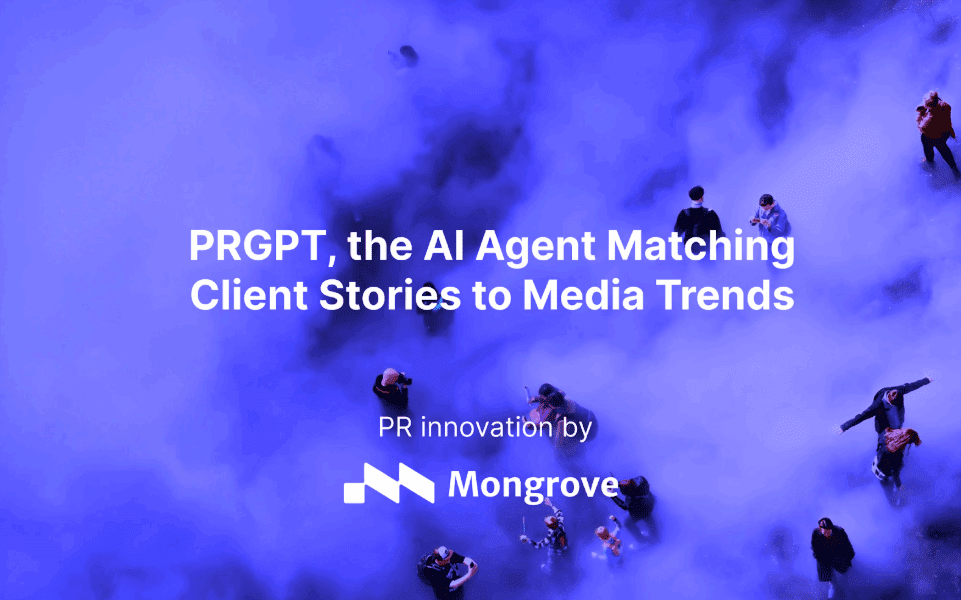Mongrove Launches PRGpt: An AI Agent That Matches Clients to Media Trends

In an era where the news cycle refreshes faster than a trending hashtag, staying relevant has become both a science and an art. For Luke James, Founder of communications firm Mongrove, the challenge isn’t just keeping up with the conversation — it’s staying ahead of it. His company’s latest innovation, PRGpt, aims to do exactly that: predict emerging media trends before they peak and help brands align their stories to them in real time.
“Public relations has always been about timing,” James says. “But timing has changed. What used to be a 24-hour cycle is now 24 minutes. PRGpt gives communicators the foresight they’ve been missing, it lets them see tomorrow’s headlines today.”
The PR Strategist That Never Sleeps
PRGpt, which Mongrove describes as “the PR strategist that never sleeps,” uses machine learning and natural language processing to monitor thousands of media sources — from breaking news outlets and industry journals to podcasts, Reddit threads, and X (formerly Twitter) conversations.
It doesn’t just flag what’s trending. It maps where conversations are forming, measures how sentiment is shifting, and matches clients’ messaging to those evolving narratives. “We built PRGpt to identify narrative gaps,” James explains. “If sustainability in fintech is trending, for example, it tells our clients where they can add credible value — not just noise.”
The idea isn’t to automate human creativity, but to enhance it. In James’s view, AI should serve as a co-pilot, not a replacement. “AI can process billions of data points in a second,” he says. “But it can’t feel cultural undercurrents, understand irony, or judge what’s truly newsworthy. That’s where human instinct comes in. PRGpt exists at that intersection — where human intuition meets machine intelligence.”
The system was developed by Mongrove’s in-house innovation lab, trained on decades of media data. Its neural engine identifies emerging patterns in language, journalist focus, and audience interest — offering predictive insights that allow PR teams to craft stories that resonate before trends reach saturation.
Data, Relevance, and the New Economics of Attention
The launch of PRGpt comes at a critical inflection point for the media industry. Global attention spans are shrinking, and traditional media models are under pressure. According to a 2024 Reuters Institute report, only 22% of people worldwide now trust news outlets “most of the time,” while social algorithms determine much of what audiences see. In this fragmented landscape, relevance isn’t a luxury — it’s survival.
“Brands aren’t just competing with their rivals anymore,” says James. “They’re competing with every influencer, meme, and viral moment on the internet. PRGpt helps level that playing field by showing where a brand’s authentic story can cut through the noise.”
Data backs this up. A Deloitte study found that brands using AI-driven communications tools saw engagement levels increase by 35% year over year, while companies that failed to adapt reported declining media visibility and slower response times to crises. Mongrove’s internal pilot programs with PRGpt clients mirrored those findings: campaigns executed using the tool achieved 43% faster media placements and over 60% higher share of voice in target categories compared to traditional planning cycles.
For Mongrove — which has built its reputation over two decades serving clients in finance, technology, and entertainment — this marks a shift from reactive PR to predictive storytelling. “We used to wait for the story to happen,” says James. “Now, we can see the story forming and position our clients inside it before it breaks.”
A Human Compass in a World of Noise
While AI is transforming every industry, few sectors are as deeply tied to human emotion as public relations. The risk, as James acknowledges, is that in chasing efficiency, communicators could lose authenticity.
“The worst thing AI could do to PR is strip away its humanity,” he says. “That’s why we built PRGpt around augmentation, not automation. It helps strategists sound more human — more timely, more relevant — by freeing them from the mechanical work of tracking every headline.”
Indeed, authenticity has become the defining metric of trust. According to Edelman’s 2025 Trust Barometer, 71% of consumers say they are more likely to engage with brands that “communicate with transparency and empathy.” Yet the same report notes a widening “trust gap” between institutions and audiences overwhelmed by AI-generated noise.
Mongrove hopes PRGpt can help narrow that gap by embedding ethical safeguards within the platform. The system can flag misinformation risks, verify journalist credentials, and detect anomalies like deepfake usage or synthetic news distribution — challenges that have grown exponentially with generative AI.
“Reputation today is a fragile currency,” James says. “One deepfake can undo years of credibility. Our technology is designed to protect as much as promote.”
From Reputation to Revenue
PRGpt also represents a broader evolution in Mongrove’s strategy. Following its 2024 acquisition of UK-based LimitlessB2B, a data-driven lead generation firm, the company began blending its communications expertise with marketing analytics — bridging what James calls “the final gap between reputation and revenue.”
“The PR industry is finally quantifiable,” he explains. “For decades, we’ve been asked to prove ROI. With PRGpt, we can show in real time how earned media attention translates into measurable business outcomes.”
The integration of predictive analytics and CRM data allows clients to see how a surge in positive media coverage affects everything from brand perception to lead quality and conversion. For multinational companies juggling multiple markets, the benefits are clear: faster insights, more targeted messaging, and a unified understanding of how public sentiment drives sales and investor confidence.
As AI matures, Mongrove plans to expand PRGpt’s capabilities into 12 languages and embed cross-cultural context modeling — recognizing that tone, humor, and authority differ dramatically between markets. “A successful story in New York may not work in Jakarta or Berlin,” says James. “Our goal is to help brands communicate boldly across borders, but always with local authenticity.”
The Future of PR Is Predictive
For an industry built on relationships and timing, PRGpt may represent a paradigm shift. It signals a move from reactive to proactive communication — from responding to headlines to writing them.
James, however, sees this not as a disruption but as a restoration. “Public relations was always meant to anticipate — to sense what matters before everyone else does,” he reflects. “We’ve just built the technology to make that instinct scale.”
As media ecosystems become more complex and attention more fragmented, PRGpt’s promise is simple yet profound: to bring clarity to chaos. By marrying human creativity with machine intelligence, Mongrove is betting that the future of influence will belong to those who can see it coming.
“Relevance is the new currency,” says James. “And foresight is how you earn it.”


